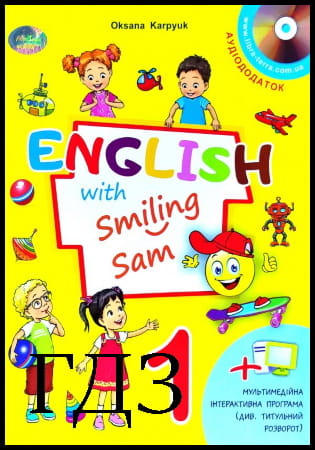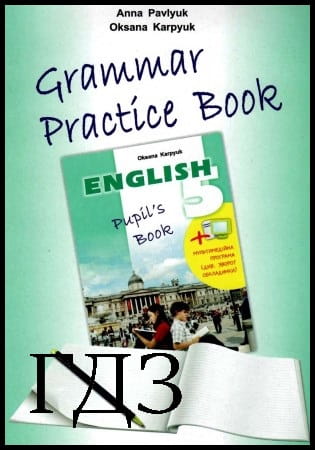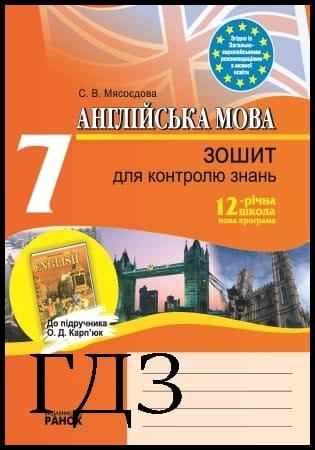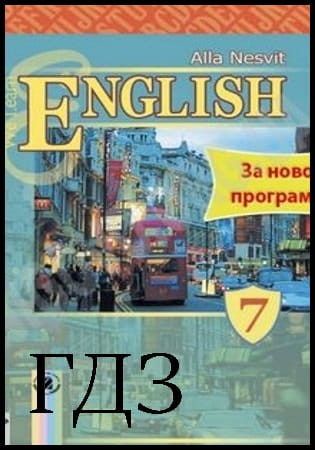ГДЗ Англійська мова 6 клас. Підручник [Калініна Л.В., Самойлюкевич І.В.] 2014
Unite Six: Help Yourself to…
p. 158-159, ex. 2b. We have got a lot of tomatoes at home.
We haven't got a lot of eggs left.
We have got a little cheese left.
p. 159.
At Home. Traditionally, we have a three-course dinner. Mum is good at cooking borsch. We usually eat it on Sunday. Mum also often cooks meat dumplings for dinner. We eat them with vegetables. We usually have fruit for dessert and drink tea or coffee.
p. 159, ex. 1a.
the eating habits in your family.
Traditionally, we have a three-course dinner.
Traditionally, we have fruit for dessert. Traditionally, Mum is good at making cakes.
p. 159, ex. 1b.
Mum is cooking style.
My mum often cooks meat dumplings for dinner.
My mum often cooks cabbage rolls for supper.
p. 159, ex. 3.
I think the mother enjoys a cup of coffee for dessert.
I think the father enjoys a cup of tea and a cake for dessert.
I think the son enjoys a sandwich for dessert.
I think the daughter enjoys fruit salad for dessert.
p. 160, ex. 2.
1. What did Lucy's mother cook for the first course? — Lucy's mother cook for the first course Ukrainian borsch with pampushkas.
2. Why does Lucy prefer vegetables to begin with? — They are full of vitamins and low in calories.
3. What do they usually have for the main course? — The main course of ten consists of chops and mashed potatoes for garnish.
4. Who has a sweet tooth in Lucy’s family? — Lucy has.
5. Lucy's mother is good at cooking traditional Ukrainian dishes, isn’t she? — Yes, she is.
p. 160, ex. 3.
Example: Lucy has a three- course dinner. Me too.
1. Lucy’s dinner starts with appetizers. Me too.
2. Lucy chooses vegetables. Me too.
3. For the first course they eat Ukrainian borsch. Me too.
4. The main course often consists of consists of chops and mashed potatoes for garnish. — I usually eat chicken.
5. Alternatively they may have varenyks stuffed with cottage cheese, — We may have meat dumplings.
6. For dessert she prefers a piece of apple pie and a glass of compote or just a cup of tea. — I usually prefer fruit.
p. 161, ex. 2.
A: It’s dinner time. Are you hungry?
B: Of course. I am really hungry.
A: You usually have a three-course dinner, don't you?
B: Yes. This is our traditional dinner.
A: I bet, you start with appetizers.
B: Yes, I like to begin some vegetables.
A: Don’t you have a sweet tooth?
B: Yes, I have/1 really love sweets and cakes.
p. 161, ex. 3.
As usual, it will start with appetizers, like cucumber or cabbage salad, ham or sausage, cheese or smoked fish. I’ll certainly choose vegetables- they are full of vitamins and low in calories. For the first course it will be my mum's specialty — Ukrainian borsch with pampushkas, naturally, mum serves them with garlic. The main course often consists of chops and mashed potatoes for garnish. Alternatively, we may have varenyks stuffed with cottage cheese. For dessert, I prefer some fruit.
p. 161, ex. VIII.
Traditionally, we have a three-course dinner. Mum is good at cooking borsch. We usually eat it on Sunday. Mum also often cooks meat dumplings for dinner. We eat them with vegetables. We usually have fruit for dessert and drink tea or coffee.
p. 162, ex. I.
We have a food processor in our kitchen. We can use it for cutting vegetables.
We have a microwave in our kitchen. We can use it for cooking and heating up.
We have a saucepan in our kitchen. We can use it for cooking.
We have a frying pan in our kitchen. We can use it for heating up.
p. 164, ex. 1a.
I can slice bread with a knife.
I can chop tomatoes with a knife.
I can boil and stew in the saucepan.
I can fry meat or fish in the frying — pan.
I can mince, grate, mix with a food processor.
I can bake, roast, grill in an oven / micro- wave.
p. 165.
At home.
1. What kitchen objects you have?
2. What you can do with them?
3. What cooking skills you can practice there?
We have a food processor in our kitchen. We can use it for cutting vegetables.
We have a microwave in our kitchen. We can use it for cooking and heating up.
We have a saucepan in our kitchen. We can use it for cooking.
We have a frying-pan in our kitchen. We can use it for heating up.
We have a coffee — machine to make coffee.
p. 165, ex. 2.
1. What does it look like?
2. What can we do with it?
3. Where do we keep it?
It is on the table. It looks like a small ma-chine . We can use it f or cutting vegetables. (a food processor)
p. 166, ex. 2.
1. Kate knows much about baking. — false.
2. Kate can’t use the oven. — false.
3. Paul compliments Kate about cooking. — true.
4. Paul’s kitchen is well-equipped. — true.
5. Cooking is Greek to Paul’s mother. — false.
6. Kate is going to take cooking lessons from Paul’s mother. — false.
p. 167, ex. 2.
A: Tea is ready. Sit down to the table. Help yourself to these cakes.
B: Wow, they taste delicious. Your mum has baked them, hasn’t she?
A: Poor guess. It’s me who baked them. It was my first try.
B: And a very successful a t that. Did you fry them in the frying-pan?
A: Of course not. First I chopped the butter and mixed it with the flour and eggs, and then I minced it in the food processor. After that I put the biscuits into the oven and fifteen minutes later they were ready for us. Then I added some cream and nuts. B: One day you’re going to be the best cook in the world. You’re a real foodie.
A: Thank you for the compliment. I ‘m glad you liked my cakes.
B: I think I should take cooking lessons from you. It’ll do me good.
p. 167, ex. VI.
1) We have a food processor in our kitchen. We can use it for cutting vegetables.
We have a microwave in our kitchen. We can use it for cooking and heating up.
We have a coffee—machine to make coffee. I can do my favourite cakes. First I chop the butter and mix it with the flour and eggs, then I mince it in the food processor. After that I put the biscuits into the oven and fifteen minutes later they are ready for us. Then I add some cream and nuts.
p. 167, ex. VII.
Please, help yourself to this fruit salad.
I have helped my mum to peel bananas.
My mum was cutting’ some apples while I was chopping oranges.
First I put the fruit into the bowl.
Then I added some cream.
After that I decorated the salad with nuts. One day I am going to become a famous cook.
p. 169, ex. 1a.
to show your choice in food: I don’t like milk.
I like cheese.
p. 169, ex. 1b.
to name one of two things at dinner table:
I don’t like milk either. Let’s have tea.
p. 169, ex. 1c.
what you don’t do at dinner table either.
I'd like either a banana or a pear.
p. 169, ex. 2a.
He is too old to start playing tennis.
No, he is young enough to start playing tennis.
p. 170, ex. 1a.
What do they eat with? They eat soup with a spoon.
They eat salad with a fork.
They cut bread with a knife.
p. 171, ex, 1b.
How do they protect a table top from food or drink?
We use a table coaster and a table mat to protect a table top from food or drink.
p. 170, ex. 2b.
The boy is too active to sit at the dinner table.
The girl isn’t well-mannered enough to use a fork.
The girl is too little to eat herself.
The girl is old enough to use a fork and a knife.
p. 171, ex. 1c.
How do you protect their clothes from food or drink?
We use a serviette and a napkin to protect our clothes from food or drink.
p. 171, ex. 2.
We, the English, pay much attention to table manners. We teach our children how to behave at dinner table. There are special rules about eating. First of all, we put a table coaster and a table mat on the table for dinner to protect a table top from food or drink. We place a knife to right of a plate and a fork to the it’s left. Of course, we use a serviette and a napkin to protect to our clothes. If you follow these rules nobody will say that your table manners are bad.
Work in groups and make a list of do’s and don’ts at the dinner table
| Do’s | Don’ts |
| Use a knife and a fork. Put a table coaster and a table mat on the table. I like when people | Don't talk while eating. Don’t put too much food on your plate. Don ’ t be too active at the table. |
At home. I like when people use a fork and a knife. I like when people use a serviette and a napkin. I dislike speaking while eating.
p. 172, ex. 2.
1. Why did the children have an improvised dinner at school. — They spoke about table manners.
2. What did they have for dinner? — They had some bread, tins of stewed steak, apples and — toffees
3. Who fixed dinner for the children? — The teacher did.
4. What kitchen objects were of help? — The thing for mashing potatoes and the tea-strainer.
5. Were table manners easy enough to follow? — Yes, they were.
p. 172, ex. V.
1) The children had dinner amid great good-humour and without any table manners. They saw a lot of new things.
p. 174, ex. 2.
A: I think it is very important to have good table manners.
B: Please tell me what I should do.
A: Firstly, remember to behave yourself in a proper way. Besides put a table coaster and a table mat.
B: And what about protecting the clothes?
A: You’ll be safe if you use a serviette and a napkin, Never forget about the etiquette. B: Should I use a fork or a knife?
A: I think you’d better put the knife on the safe side.
B; Thank you very much, you know how to behave.
A: Mind your table mariners.
B: Don’ t worry, I will.
p. 174, ex. 3.
One day the teacher broke the news to the children and said we were all staying at school for dinner. She said that we are going to celebrate the end of the term. She brought some fruit, cakes and cheese for sandwiches. We made tea and used a tea strainer. We presented our teacher with flowers. We all were happy.
p. 174, ex. VI.
Don’t put elbows on the table.
Be always grateful.
Never speak while eating.
Hold forks and knives correctly.
Sit up straight.
p. 175-176, ex. III.
a) — What does pudding taste?
Yummy! It tastes delicious and sweet.
b) — What does fried chicken smell?
— It smells appetizing.
c) — Help yourself to the pine apple. Do you like it?
— Oh, it smells good but it tastes bland. c) — May I treat you to grapes?
— Thank you. How nice they smell!
p. 176, ex. 1.
If you ask me, I like a banana pie.
It is my favourite dish.
11 smells appetizing.
Besides, it tastes delicious.
At the sight of it I want to eat it immediately..
p. 177, ex. 2.
1. Could you do me a favour?
2. It’s Helen’s favourite SDonere cake.
3. Can I ask you a favour?
4. Can we have strawberries? They are my favourite.
5. What’s your favourite colour?
p. 177, ex. 2.
— How do you like chips with bacon and cheese? You can take either.
— They taste strange for me. I prefer French fries.
— And I like Lucy's apple pies. They smell nice and taste delicious..
— Agreed Lucy is a real foodie.
p. 177.
At home. My Dad likes Ukrainian borsch. It tastes delicious.
My Mum likes chicken, — It smells appetizing.
My sister likes meat dumplings. They smell appetizing.
I like fruit salad. It tastes delicious and sweet.
p. 178, ex. 2.
A: Help yourself to lemon cake.
B: Wow! It’s my favourite.
A: What does it smell?
B: It smells appetizing.
A: What does it taste?
B: It tastes delicious A: Bon appetite.
р. 179, ex. I.
is; tastes; goes; was; was; have sold; go
р. 179, ex. I.
is; tastes; goes; was; was; have sold; go
p. 179, ex. VIII.
Dear Mike!
Thank you so much for invitation to your birthday party. The party was wonderful. The food tasted very delicious.
Your mum is the world's best cook.
Yours, Ben.
p. 180, ex. II.
Fill in the right word.
1. Fruit salad is full of vitamins.
2. We’ll have a three-course dinner today.
3. My mum knows a lot of kitchen objects.
4. The pudding tastes like nothing on Earth.
5. Mind your table manners.
6. You're a real foodie.
p. 180, ex. III.
1. Help yourself to some biscuits. — c) They smell delicious!
2. This is my favourite sponge cake. — a) Wow! It tastes like nothing else on earth!
3. How do you like this apple pie? — e) It smells good, but the apples taste a bit sour.
4. May I treat you to some grapes? — d)No, thanks. I'm not a fruit person.
5. Would you like some peaches?—b) With pleasure. I love peaches and apricots.
6. Let's have a cabbage salad to begin with. — f) Agreed. Vegetables are full of vitamins.
p. 180—181, ex. IV.
1. When do English people have lunch? — B. early in the afternoon.
2. What do many English people have for lunch? — C. a sandwich.
3. What is a sandwich? — C. two or more slices of bread with some products between.
4. How should you eat a sandwich? — A. with your hands;
5. What is not true about dogwood sandwiches? — C. They are in British style.
6. When did first sandwiches appear? — C. in the 17th-18th centuries.
p. 182, ex. VI.
I enjoy cooking very much. Help yourself to my favourite cakes. First I chopped the butter and mixed it with the flour and eggs, and then I minced it in the food processor. After that I put the biscuits into the oven and fifteen minutes later they were ready for us. Then I added some cream and nuts. I’m a foodie, and you?
 ГДЗ Англійська мова 7 клас Калініна Самойлюкевич 2014 Генеза Підручник
ГДЗ Англійська мова 7 клас Калініна Самойлюкевич 2014 Генеза Підручник
 Якщо помітили в тексті помилку, виділіть її та натисніть Ctrl + Enter
Якщо помітили в тексті помилку, виділіть її та натисніть Ctrl + Enter 02.02.2021,
02.02.2021,
 1 560,
1 560,
 0
0
 Назад
Назад




![ГДЗ Природознавство 5 клас. Підручник [Ярошенко О.Г., Бойко В.М.] 2018 ГДЗ Природознавство 5 клас. Підручник [Ярошенко О.Г., Бойко В.М.] 2018](/uploads/posts/2019-04/1555779316_5_p_y_u2018.jpg)
![ГДЗ Основи правознавства 9 клас. Підручник [Наровлянський О. Д.] 2017 ГДЗ Основи правознавства 9 клас. Підручник [Наровлянський О. Д.] 2017](/uploads/posts/2019-02/1550928122_9k_p_n_2017.jpg)
![ГДЗ Українська мова 8 клас. Підручник [Глазова О.П.] 2021 ГДЗ Українська мова 8 клас. Підручник [Глазова О.П.] 2021](/uploads/posts/2021-10/1633720388_8k_y_g_2021.jpg)
![ГДЗ Вступ до історії 5 клас. Підручник [Гісем О.В.] 2018 ГДЗ Вступ до історії 5 клас. Підручник [Гісем О.В.] 2018](/uploads/posts/2019-07/1564163269_5k_i_h_2018.jpg)